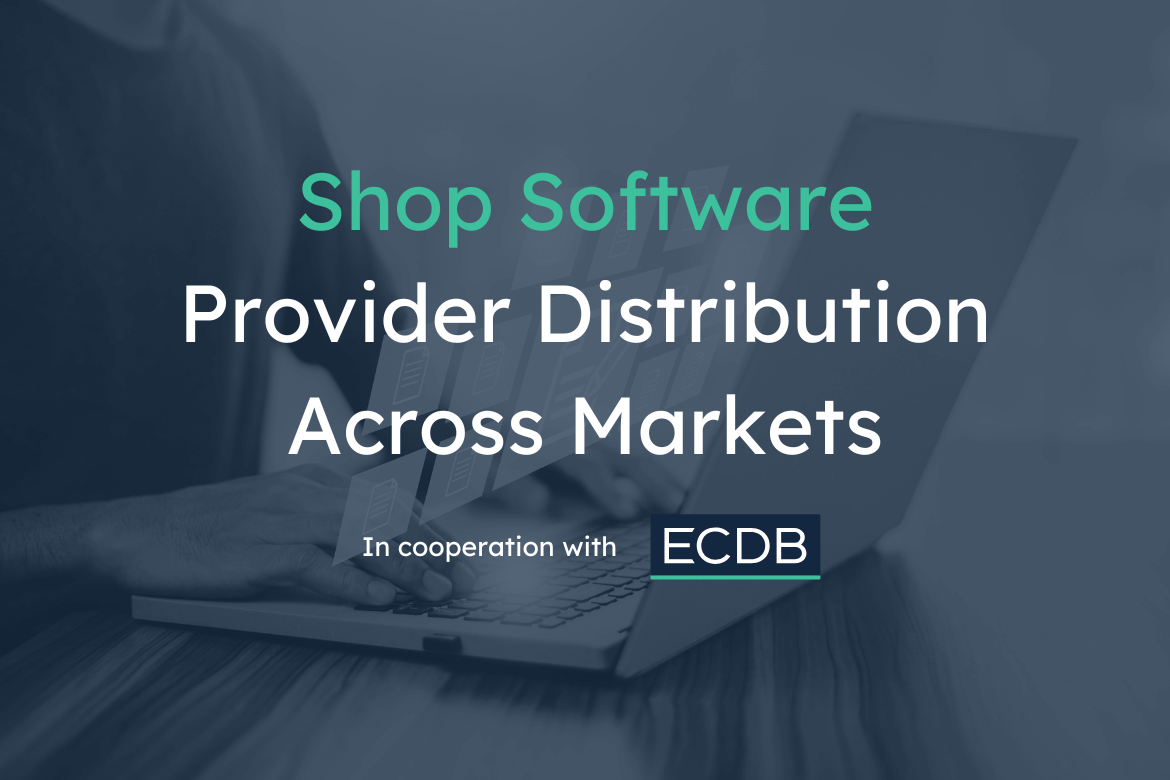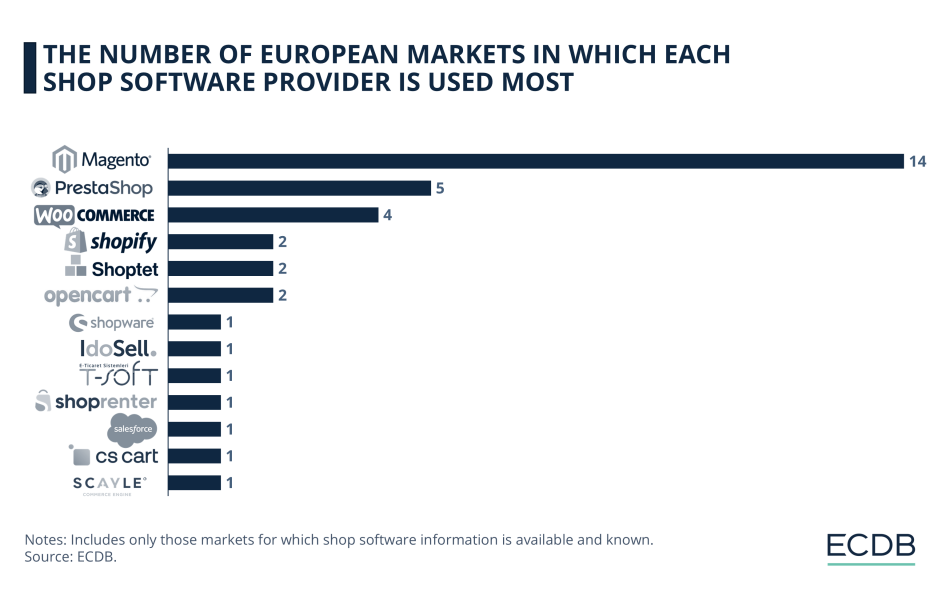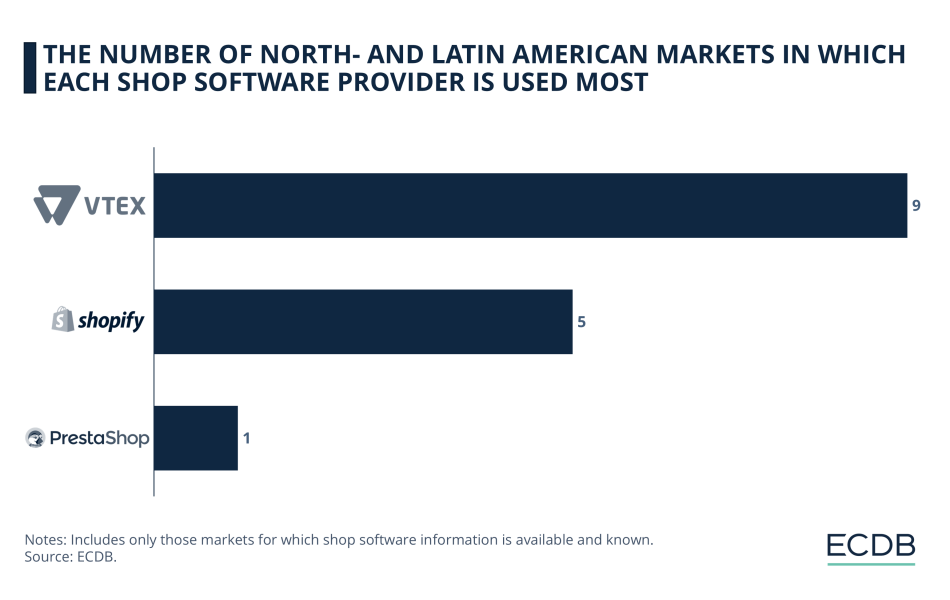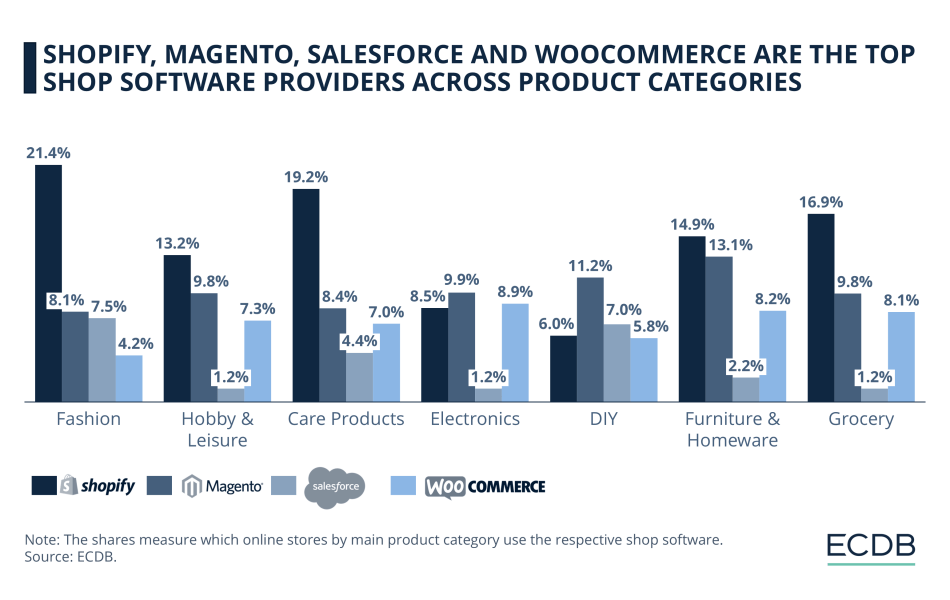The top shop software providers and their distribution across markets
Written by
Editorial TeamPublished on
Read new insights from ECDB on the subject of shop software and its provider distribution across different markets. (Ad)

Commercial collaboration
Nadine Koutsou-Wehling, Data Journalist at ECDB
Shop software is an important pillar of the eCommerce industry, essentially allowing businesses to build an online store without the need for a large IT department to manage the digital infrastructure.
The importance of shop software has grown in tandem with the number of providers selling this service to businesses. The range of businesses using shop software includes small and large companies, whereas the largest tend to use their own software that smaller retailers can integrate for their convenience.
Navigating the variety of providers for shop software depends on many factors including ease of use, cost structure, and regional preference. As our extensive data here at ECDB shows, regional clusters tend to form in shop software adoption. But there are other aspects to consider, some of which are discussed here.
The two largest shop software providers and where they are most used
The two largest shop software providers, Magento and Shopify, are a prime example of the spatial distribution pattern. Plotting their preferred usage on a world map shows how regions of the world tend to favor one shop software provider over the other.
Please note that the map shows which one of the two shop software providers is more represented in the country, which doesn’t necessarily mean that they are the most used.

Explaining why these preferences exist is a complex topic that cannot be covered by a single influence. Certainly, there is cultural proximity to consider, given that the United Kingdom and Ireland are the only European markets where Shopify has the upper hand, as it does in the United States and Australia.
Part of this is Shopify’s origin as a Canadian platform, which meant that it relied heavily on English-speaking markets throughout its expansion. Magento was not very different at first, as it was founded in California. But over time, Magento grew stronger outside of its home market, as its status as an open-source platform meant that more international developers could customize it to meet their specific needs.
After Magento was acquired by Adobe in 2018 to become the Adobe Commerce Cloud, the international focus was expanded. Magento as an open source and an essentially free-to-use platform remained, however, which is a huge factor for cost-conscious businesses to save money instead of opting for a subscription-based platform such as Shopify. Magento has the disadvantage of being more difficult for a beginner to use, requiring programming skills or extensive assistance – the software generates revenue by offering extensions or development, making it highly flexible and adaptable to user needs.
Europe’s preferred provider is Magento, but diversity prevails
Despite their popularity, Shopify and Magento are certainly not the only players in the space – nor are they the most widely used in many countries. Ranking the respective number one shop software provider by market shows that there is both a tendency to go with the best-known as well as an existing diversity.
Take Europe, for instance: The continent consists of a diverse set of markets, with different languages, industry focus, digital maturity and consumer, payment, and shipping preferences.

Magento’s popularity is reflected in the number of markets it ranks as the number one shop software provider, which is 14. Shopify lags with only 2 markets, the UK and Ireland. But Shopify is highly popular in Asian markets, where it ranks number one, like in India, Pakistan, Malaysia and Japan.
Other successful shop software systems are provided by PrestaShop and WooCommerce, both with 5 and 4 European markets, respectively, where they rank first. They are followed by a large number of scattered providers that are most used in one market. Examples include IdoSell in Poland, CS Cart in Latvia, SCAYLE in Cyprus and more.
VTEX dominates Latin America, Shopify ranks first in North America
The differences are less pronounced in the Americas, but patterns are evident here as well.

Shopify ranks first in 5 markets: the United States, Canada, Mexico, Colombia and Chile. But overall, VTEX is more often represented as the number one provider on the continent. It surpasses Shopify with 9 markets, including Brazil, Ecuador, Guatemala, Peru, Uruguay, Panama, Argentina, El Salvador and Costa Rica.
Similar to Shopify, VTEX’s origins deeply influence its penetration in Latin America. VTEX was founded in Brazil, so it is highly attuned to the region’s payment structure, shipping peculiarities, and regulatory requirements. Another important factor is that VTEX is particularly suited to the marketplace model, which accounts for the majority of eCommerce revenues in the region. Its added benefit is the easy integration of physical and online channels, a relevant feature for many brands on the continent.
Thinking about partnerships between companies can explain how a synergistic effect can influence the integration of shop software across regions: Integrations of features and use cases of partners are likely to influence the choice.
Shopify performs best across most categories
Shop software does not entirely hinge on regional distribution, the product category that stores sell also have an impact.

Shopify tends to be adopted by online stores which mainly sell Fashion, Hobby & Leisure, Care Products, Furniture & Homeware and Grocery. Magento performs best in online stores that mainly sell Electronics and DIY.
This distribution is no coincidence. Which product categories online stores offer influences the shop software they most likely would choose, as the features of shop software allow for higher customization or more direct purchasing processes.
Due to Magento’s highly flexible settings, online stores can offer more complex choices to customize products, which applies to Electronics, DIY or Furniture, where Magento is used frequently.
Salesforce ranks a consistent third, except for Electronics where it comes behind Magento. WooCommerce is the least used in most cases, except for Hobby & Leisure, Electronics, Furniture & Homeware and Grocery.
Shop software adoption: A complex landscape
The choice of shop software hinges on multiple factors, some measurable, some not so much. They include regional, business and product-related factors. While Shopify and Magento stand out globally, their usage patterns reveal clear geographical preferences and align closely with the specific needs of different product categories.
Regional champions like VTEX in Latin America prove how local roots and tailored features impact adoption. In effect, businesses choose shop software in the context of highly individualized needs, the statistics of which can approximate the various use cases that exist in real life.
***


